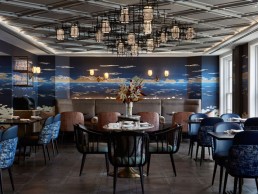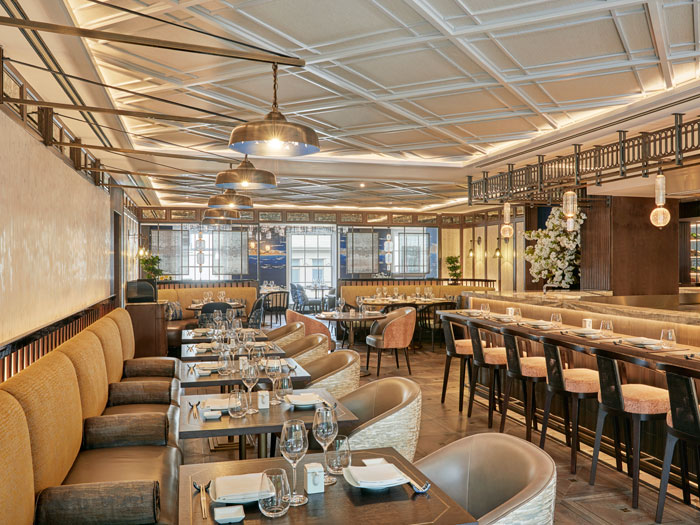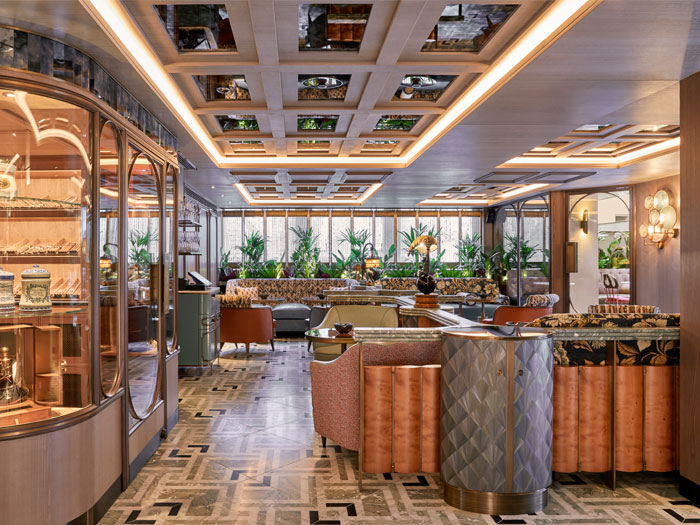
The Arts Club, UK
Joyce Wang Studio’s refurbishment of The Arts Club London, completed in the summer of 2019, features brand new designs in the Kyubi restaurant and Oscuro cigar lounge. darc speaks with Firefly Point of View and Joyce Wang about the project’s influences and their collaboration.
The Joyce Wang Studio, best known for its luxury hospitality and residential design portfolio, completed the new schemes for The Arts Club in London in June 2019. Both the Kyubi restaurant and newest club edition, the Oscuro cigar lounge, are intimate and richly textured, providing club members with a home away from home setting in Central London.
The revised Kyubi restaurant now occupies a larger floorplan on the third floor of The Arts Club, while Oscuro occupies the restaurant’s previous setting on the second floor of the Mayfair club and extends onto a private terrace.
The visual journey that guides guests through the cigar lounge involves tobacco hued woods, bold florals and tobacco leaf motifs. The design incorporates cosy nooks, bar stools positioned around a custom designed pewter and scallop leather fronted bar and high stools away from the bar to create areas for guests to relax and enjoy food, drink and the finest cigars.
“The brief was to create a cigar lounge that welcomes both cigar afficionados and those who may not be fans of cigars; especially to create an environment that feels friendly and fresh to women in what was historically a male-dominated typology of space,” explains Joyce Wang, founder of Joyce Wang Studio. “The cigar lounge also houses the member’s collection of cigars.
“Kyubi’s brief was actually to move the existing smaller Japanese restaurant up a floor into a larger space to satiate growing demands of membership. Kyubi now showcases its impressive sake collection with a dedicated sake bar and omakase sushi counter.”
To complement the overall attention to detail in furnishings and atmosphere for this project, Firefly Point Of View (FPOV) was brought in to enhance the spaces with both architectural and decorative lighting.
Peter Veale, Design Director at FPOV, discusses their involvement in the project and the lighting choices. “We knew the head of design at The Arts Club from when she worked at an interior design consultants that we’d previously worked with. To be honest, there was no initial brief, so we set about trying to create something a little different from what The Arts Club had looked like before. Luckily, [Joyce Wang] had the same idea,” he says.
“As is the case with most hospitality spaces, the decorative lighting was critical to set the mood. The interior designers led the way here and we gave comments and worked with them on the bespoke designs.”
The team at FPOV chose a selection of decorative lighting fixtures, including a large bespoke pendant, Ferro, by Cox London, bespoke pendants from Phillips and Wood, the Narrow Pillar lights and School pendants from Original BTC and bespoke wall and table lamps from Hoad and More, to complete the overall stylised looks for each space in the project.

“The Kyubi restaurant is Japanese,” explains Veale. “So, everything had to feel in-keeping with that concept. The mixture of modern decorative lighting makes the space more fun and playful than if there had been more repetition.
“There’s often a difference in the mindsets of designers and operators and that gap needed to be bridged during this project. It’s all about client expectation; to make sure you explain your design and how it’s installed and maintained,” he adds.
“We were closely involved in the custom luminaire in Kyubi, which had to be manufactured quickly and within budget.”
The sculptural chandelier in the main dining room Veale references is composed of iron strokes representative of Japanese calligraphy and suspended glass blocks; casting fluid beams of light onto the colonial linen ceilings.
Wang elaborates further the design influences for Kyubi, taking “cues from the Meiji period whereby western influences first entered Japan. The interiors are a careful curation of authentic antiques and custom finishes that showcases the refined craftsmanship and decorative arts at the time.
“Kyubi looked to celebrate individual materials. The overall colour palette and feature mural took reference from ancient Japanese artworks, with indigo ombres, whites, papayas and burnt oranges. Luxurious fabrics sourced directly from Japan, such as HOSOO’s metallic thread fabrics help to add a contemporary touch to the space,” she adds.
“The architectural features have taken direct reference from the Meiji period. Parquet inspired by Yosegi patterns with contemporary metal inlays, ceiling mouldings with inset textured wallpaper and areas of dark timber wall panelling with antique mirrors inspired by western colonial and traditional Japanese architecture.
“Antique Amari lamps were purchased for the sake bar, bringing authenticity to a key area within the restaurant. This identity was brought in further through the sake barrels and general accessories throughout the whole restaurant.”
Moving into the Oscuro cigar lounge, the interior design took a more adventurous tone, allowing the designers to flex their creativity a little. As Wang explains, the inspiration for the theme was that of “a journey of a monkey through a Cuban jungle”.

“The marble rails that frame the banquette were envisioned as its very own catwalks, whilst the rodded screens represented the vines that it might scale on,” she says. “It’s not inspired by any particular film, but the interiors are meant to be unravelled frame by frame as we compositionally create vignettes for the guest to experience.
“We imagined the Oscuro lounge on the balmy night of the Cuban jungle where its spirited animal – the monkey – takes ownership of the place. Playful and eclectic upholstery is set amongst organic ferns and palm leaves; ceilings are clad in mirrors in which the Maitland Smith monkey finds its own reflection.”
The design team chose to layer up the materials in the cigar lounge, using warm grey timbers on the walls, which provide a backdrop to the eclectic florals and bold patterns. Armchairs are covered in tree bark and tobacco-referencing fabrics and rare, golden veneers on low level partitions, along with feature marbles such as Verde Antigua, inject the space with fresh, tropical colours. “Tobacco leaf tabletops, textured holophane and bevelled glass add to the overall classic and timeless quality of the space,” says Wang. “Finally, two monkey lamps give a direct nod to the overarching story.”
In both spaces, the furnishings and lighting chosen by the teams were predominantly custom designed with a few vintage items thrown into the mix. In the Oscuro lounge, Wang took advantage of the smaller cover numbers and introduced some vintage armchairs, which helped to add to the overall character and sense of belonging in the room. Decorative lighting and accessories were then added in to inject an added layer of personality into the space.
Overall, in order to complete the desired looks for each space, Veale adds on the importance of using lighting to bring a scheme together: “Mood and function. All the lighting serves a purpose as well as sets the tone, be it a pendant to light a table or a wall light to ensure that no surface becomes dark and gloomy”.
He adds: “The decorative lighting took priority. Only when it’s not going to provide enough light did we add architectural lighting. Multiple layers meant that no one layer needed to be too bright and uncomfortable.”
Overall, Veale reflects on the project’s success coming down to a great partnership with Joyce Wang and her team. “We were both striving towards the same seamless effect – they were very good collaborators, and we are very happy with the end results.”



